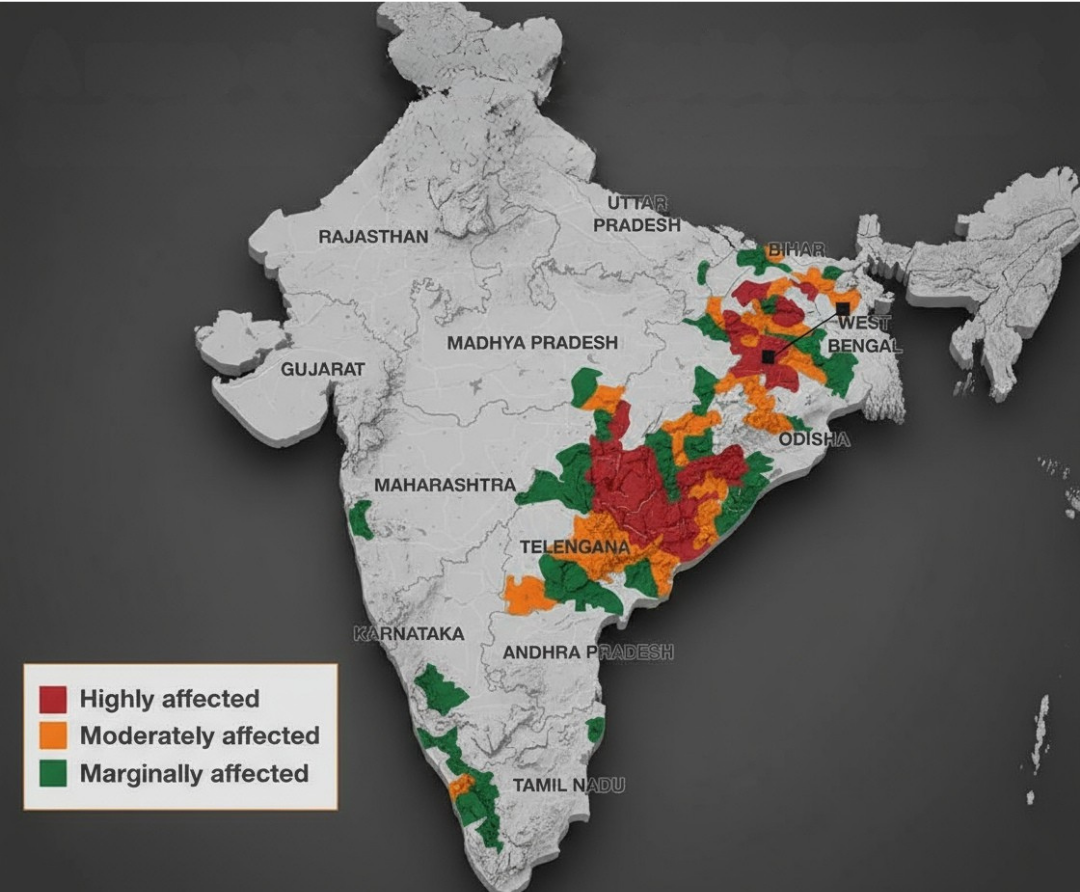Left Wing Extremism in India: A Deep Dive Analysis
LWE is a critical topic for UPSC Prelims and Mains, especially under the security and governance segments. Understanding its history, ideology, affected areas, government strategies, and challenges provides insights into India’s internal security dynamics.
Introduction
Left Wing Extremism (LWE), also known as Naxalism or Maoism, represents one of the most significant internal security challenges faced by India. Originating as a peasant revolt in 1967 in the village of Naxalbari, West Bengal, this ideological and armed movement seeks to overthrow the existing political system through violent revolution, driven by radical communist ideology inspired by Mao Zedong. LWE primarily targets the socio-economic inequalities faced by marginalized tribal and rural populations, asserting itself as a voice against state neglect, exploitation, and injustice.
Historical Origins
The movement began in 1967 when a faction of the Communist Party of India (Marxist), led by Charu Majumdar, Kanu Sanyal, and Jangal Santhal, spearheaded the Naxalbari uprising—a peasant revolt against landlords and feudal structures. Following the split in the CPI(M), the Radical faction formed the Communist Party of India (Marxist-Leninist) in 1969, marking the formal ideological and organizational birth of LWE.
Though originating in West Bengal, the movement rapidly spread to tribal and backward areas of Telangana, Andhra Pradesh, Odisha, Chhattisgarh, Jharkhand, Bihar, and Maharashtra — regions collectively referred to as the Red Corridor.
The movement witnessed strategic consolidations such as the 2004 merger between the People’s War Group (PWG) and the Maoist Communist Centre (MCC) to form the Communist Party of India (Maoist), which remains the most dominant extremist outfit today.
Ideology and Goals
LWE ideology is heavily rooted in Maoism, an adaptation of Marxism-Leninism tailored to revolutionary struggles in rural and agrarian contexts. Key ideological tenets include:
- Overthrowing the existing democratic state, viewed as bourgeois and exploitative.
- Instituting a New Democratic Revolution to establish a classless society.
- Emphasis on armed struggle, guerrilla warfare, and a parallel “People’s Government”.
- Focus on Jal, Jangal, Jameen (Water, Forest, Land)—resources vital to tribal livelihoods and frequently under threat through industrial encroachments.
- Opposition to perceived state apathy, landlordism, capitalist exploitation, and social injustices.
Modus Operandi and Impact
The LWE groups employ violent tactics including:
- Attacks on security forces, police, and paramilitary personnel.
- Assassinations, kidnappings, and extortion of government officials and local representatives.
- Sabotage of infrastructure and disruption of development projects.
- Establishment and enforcement of parallel administrative structures in “liberated zones”.
- Targeting civilians perceived as government collaborators or informants.
- Propaganda campaigns promoting their ideology and recruiting marginalized youth.
The violence has led to significant security challenges, especially in the Red Corridor states, affecting development, governance, and law enforcement. Thousands of security personnel and civilians have died in LWE-related violent incidents over five decades.
Geographical Spread and Current Status
LWE influence remains mainly concentrated in central and eastern India, encompassing districts in:
- Chhattisgarh
- Jharkhand
- Odisha
- Bihar
- Maharashtra
- Telangana
- Andhra Pradesh
- West Bengal
- Madhya Pradesh
- Uttar Pradesh
- Kerala
Governments identify about 90 affected districts under the Security Related Expenditure (SRE) scheme. The extent of violence and geographic spread have gradually reduced with coordinated counterinsurgency efforts.
Reasons Behind the Rise and Persistence
- Economic Backwardness: Affected regions suffer from underdevelopment, poverty, lack of infrastructure, and livelihood opportunities.
- Social Exclusion: Tribal and marginalized groups feel isolated from political processes and social benefits.
- Displacement and Land Alienation: Mining, industrialization, and development projects have displaced tribal communities, fueling resentment.
- Governance Deficits: Poor implementation of schemes, corruption, feeble law enforcement, and inadequate administration create spaces for extremism.
- Ideology Appeal: LWE groups articulate genuine grievances in a way that resonates with vulnerable populations.
- Poor Access to Justice and Education: Lack of formal justice mechanisms and education perpetuates cycles of poverty and insurgency.
Government Responses and Strategies
The Indian government has adopted a multidimensional approach to counter LWE challenges:
- Security Operations: Deployment of paramilitary forces including specialized battalions like COBRA, Bastariya, Commando, and Rapid Action Forces.
- Developmental Initiatives: Targeted infrastructure development, education programs, health facilities, rural electrification, and poverty alleviation.
- Surrender and Rehabilitation: Encouraging extremists to surrender with promises of amnesty, employment, and skill training.
- Intelligence and Coordination: Enhanced intelligence sharing and joint security efforts among central and state agencies.
- Information Campaigns: Counter-propaganda efforts to dissuade locals from joining extremist groups.
- Legal Framework: Special laws and measures to prosecute and deter LWE violence.
- Tribal Empowerment: Implementation of constitutional safeguards and affirmative action for tribal welfare.
Successes and Challenges
While there has been a marked decline in LWE-related violence—by 76% since 2010—and reduced geographic spread, challenges persist:
- Strategic leadership sometimes escapes capture, ensuring continued insurgent coordination.
- Collateral harm to civilians in security operations can erode local support.
- Economic disparity and social alienation remain root causes.
- Political and administrative lapses occasionally result in ineffective implementation of schemes.
- Maoist tactics continuously evolve with new weaponry and remote terrain cover.
- Cross-border influences and support networks complicate eradication efforts.
Way Forward
Addressing Left Wing Extremism requires long-term commitments focused on:
- Inclusive Governance: Enhancing participation of marginalized communities in decision-making.
- Sustainable Development: Ensuring resource rights, livelihood enhancement, and equitable benefits from natural wealth.
- Strengthened Security: Maintaining effective, humane, and intelligence-led anti-extremism strategies.
- Education and Awareness: Building grassroots level capacities and information accessibility.
- Conflict Resolution: Providing forums for dialogue and grievance redressal.
- Regional Cooperation: Ensuring border areas are monitored to block cross-border insurgent support.
- Technological Integration: Utilizing drones, surveillance, and GIS mapping for monitoring insurgency zones.
Conclusion
Left Wing Extremism remains a complex socio-political challenge deeply rooted in India’s historical inequalities and developmental gaps. It threatens India’s unity, peace, and progress by perpetuating violence against state institutions and civilians. Balancing firm security measures with inclusive governance and sustainable development forms the cornerstone of India’s strategy to restore harmony and growth in affected regions.









